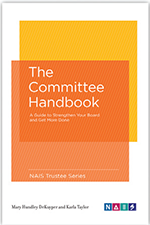 This article appeared as "Shifting Work" in the Summer 2023 issue of Independent School.
This article appeared as "Shifting Work" in the Summer 2023 issue of Independent School.Boards are no doubt deeply relieved to move beyond the panic-mode activities that marked the first years of the COVID-19 pandemic. “But I think boards want to be cautious—as do heads and faculties—that we just don’t return to what we call ‘normal,’” says Jack Creeden, head of Whitby School (CT). “What if normal wasn’t so good to begin with?”
Instead, it makes sense to take advantage of the pandemic shake-up to reassess your board’s opportunities to create a new and better normal. Now’s the time to ask questions such as: What changes have you made in governance strategy and trustee behavior that improved your results? What further changes do you need now that the landscape has shifted? And how can you lean into a new model of board work?
One area that’s ripe for reassessment is committees. All independent school boards have them. Whether their focus is governance, finance, or advancement, committees help divide up the work that facilitates the full board’s strategic deliberations and planning. But many boards harbor a nagging suspicion that their committees could be much better. In the crush of the pandemic, the best committees demonstrated that they could hone in on vital issues—not minor matters or duties that rightfully belong to the head, the faculty, and the staff. As Creeden says, “Who needs a report on what’s going on in math in high school? We need to be thinking instead about important issues in the future.”
Overhauling board committees to make them more substantive and strategic will benefit the full board, in part by saving time—an important consideration as volunteers grow more selective about how they spend this scarcest of resources. It will also make committee service more rewarding. As author Harold J. “Si” Seymour wrote, “The usual trouble with volunteers is not killing them with overwork, but simply boring them to death.”
To start improving committee work, boards should focus on tackling two issues in the near term: what work the committees should be charged with and—once that’s been determined—how to streamline committees to get the most done.
Back to the Future
Here’s a major indicator that a committee is mired in tactical matters: “If your board committees believe they need the head’s perspective on a whole bunch of issues, those might actually be operational issues” they’re focusing on, Creeden says. “If the head’s out too many nights a week [at committee meetings], you have to ask: How future-oriented is the agenda, really?”Indeed, the best committees are, like the best boards, future-oriented. Ideally, committees are not just a school’s workforce. When deployed effectively, they can also be what governance consultant Glenn Tecker calls a thoughtforce—offering informed advice and proposing substantive ideas and initiatives. Committees should be doing deep-dives into what the board needs to know to correctly handle its high-level oversight and strategic functions. Then committee members can present well-researched, well-thought-out recommendations to the full board for discussion and decision-making. It saves time and yields more valuable results.
For example, are committees looking into the forecast for school financial models, projections about the teacher workforce, and relevant trends in educational innovation? Or are they studying the drop-off and pick-up lines? Quoting Harvard sociologist David Riesman, Creeden says that the role of the board is to protect the future from the present. If a school has lots of committees with a fuzzy focus, now is a good time to ask the questions Creeden raises: “Are they future-oriented? Or are they a disguised way to get involved in tactical issues?”
For Best Effects
Many nonprofit boards have concluded that less truly is more. In 1994, boards had an average 6.6 standing committees, according to BoardSource, an organization that promotes excellence in nonprofit governance. By 2021, the number was 4.1.In his board workbook Reshaping the Volunteer Workforce, governance consultant Tecker summarizes the challenge this way:
[A board’s] work structures should be sized right to effectively accomplish the work. They should not include entities that (a) have no role or responsibilities, (b) overlap with one another, (c) slow the overall governance and decision-making process, and (d) do not contribute to [the organization’s] strategic direction. For many [organizations], this means that their committee or work group structures need to go on a diet, eliminating dead wood and reducing the overall level of bureaucracy.
Strong words like these make the justification for streamlining committees seem straightforward. But figuring out how to do it may not be. The thought of questioning longstanding committees can seem foreign—or even mutinous. A big reason is that some committee chairs, members, and even staff liaisons may feel threatened by the prospect of losing a board-related position. You may hear, “But we’ve always had the White-Glove Committee! We don’t want to get rid of it because it’s a legacy!” says Andrew Davis, associate vice president of member education and outreach at BoardSource. “But once you realize that a certain committee is a waste of time, or maybe even that it never meets, it can feel awkward to argue that you do still need it.”
But reconsidering and reordering board committees can seem less like a loss and more like a sound way to conduct business.
Consider a zero-based approach. BoardSource defines this as starting with a clean committee slate every one or two years. After assessing current strategy and priorities, the board agrees to create or re-create only the committees and task forces that fit those needs. The members of each group understand that they will disband when they fulfill their charge, or the board decides the work group is no longer needed.
Conduct a blue-sky exercise. Encourage board members to ask questions such as, if our board did zero-base its committees and start fresh, what groups would we retain and what would we dissolve? Or if we leave our committees as they are, unexamined, what do we have to be afraid of—in other words, what might be at risk?
Conduct an anonymous survey among members of each committee and its relevant staff. Governance consultant Cathy Trower says these two questions are especially valuable:
- In the past year, what was the most important strategic or fiduciary-related work this committee accomplished?
- In the year ahead, what is the most important work you think the committee should be charged with doing?
Conducting regular committee assessments is a process that will grow easier with time. If boards haven’t done one since the start of the pandemic, the next board retreat is a perfect opportunity. The prospect of change will grow less threatening. And committees will get better at focusing on strategies for the future instead of tactical needs of the present.
